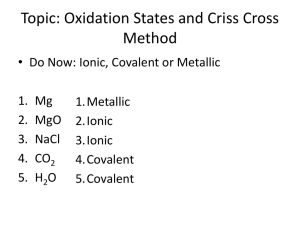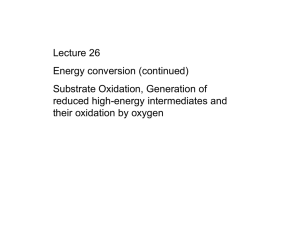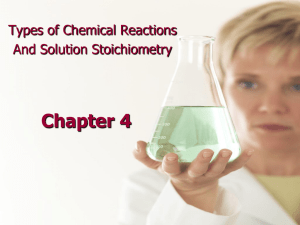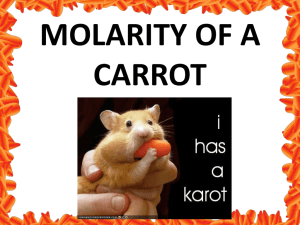Chapter 4 Notes
advertisement
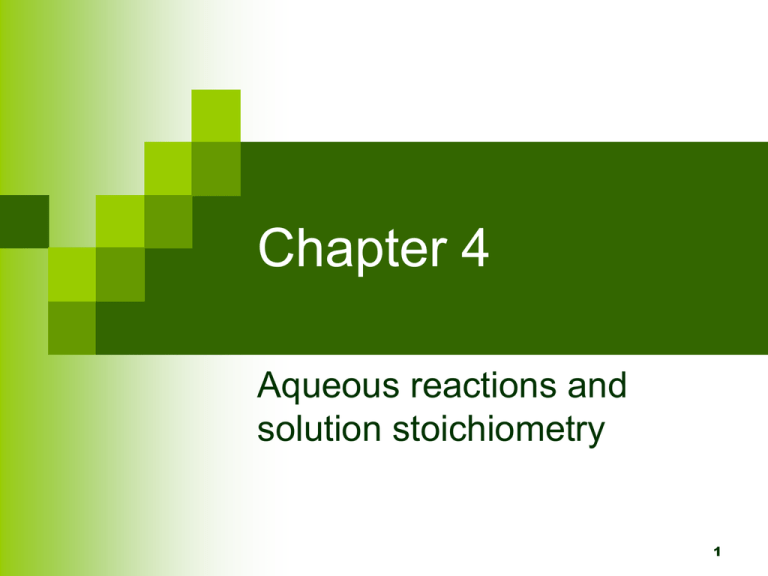
Chapter 4 Aqueous reactions and solution stoichiometry 1 Aqueous Chemistry Virtually all chemistry that makes life possible occurs in solution Common tests for sugar, cholesterol, and iron are all done in solution. 2 Solution Vocabulary Solution: Homogeneous mix of 2+ substances Solvent: dissolving medium (water, oil, liquid nitrogen), present in larger qty. Solute: what is being dissolved (salt, sugar, sodium hydroxide), present in smaller qty. Aqueous Solution: When water is the dissolving medium (Making Kool-Aid) Electrolytes: substance that dissolves in water to yield a solution that conducts electricity. (salt water) 3 Solution Solvent Solute H2O Sugar, CO2 Air (g) N2 O2, Ar, CH4 Soft Solder (s) Pb Sn Soft drink (l) 4 4.1 4.1 General Properties of Solutions One of the properties of water is its ability to dissolve MANY different substances. Polar: unequal distribution of charges makes water polar, allowing it to dissolve solutes. 5 Ions dissolving in water Ionic substances such as salts dissolve in water to release cations (+) and anions (-). Ex: NaCl -> Na+ , Cl- The dissociation of NaCl is called hydration. 6 Solvation- The process in which an ion or a molecule is surrounded by solvent molecules arranged in a specific manner. Hydration – solvation with water as solvent 7 A Note On Dissociation You must memorize the charges or all the ions and poly atomic ions in order to predict how molecules will dissociate. If you don’t know them by now you are in trouble. Make flash cards and study! 8 Solubility The amount of a substance that dissolves in a given volume of solvent at a given temperature. If ionic compounds are not greatly attracted to the ions in water then that compound will be less soluble in water. 9 What is not soluble in water? Like dissolves like In general polar (unequal distribution of charges) and ionic substances are expected to be more soluble in water than nonpolar substances. 10 Electrolyte Vocabulary Ionization: the process of adding or removing electrons from an atom or molecule. Which gives the atom a net charge. Complete Ionization: substances that only exist as ions in solution 12 Strong and Weak electrolytes Strong electrolyte: ionize completely in water (single arrow). Are good conductors of electricity Ex: Strong acids, strong bases and salts. 13 Weak Electrolytes Ionize partially in water (double arrows). Poor conductors of electricity Ex: weak acids (acetic acid shown), weak bases, partially soluble salts. And thus The reaction is reversible 14 Non-electrolytes Do not IONIZE in water or conduct electricity. They are covalent compounds that are not acids or bases. Dissolve in water as molecules instead of ions. Sugar (C12H22O11) 15 Identify the strong and weak electrolytes. 16 An electrolyte is a substance that, when dissolved in water, results in a solution that can conduct electricity. A nonelectrolyte is a substance that, when dissolved, results in a solution that does not conduct electricity. nonelectrolyte weak electrolyte strong electrolyte 18 4.1 Molecular Compounds 19 Homework Chang pg 157 # ‘s 1 2 4 7 11 BL Pg 145 #’s 3, 5, 6, 7, 8 20 4.2 Precipitate Reactions Reactions that result in the formation of an insoluble substance. (-) anion (+) cation Ag(NO3)2 (aq) + 2NaI (aq) AgI2 (s) + 2NaNO3 (aq) 21 22 Question How would each molecule dissociate? Label cations and anions. NiSO4 Ca(NO3)2 Na3PO4 Al2(SO4)3 23 Answer Ni 2+ SO4 2Ca2+ (NO3)2 Na3+ PO43Al23+ (SO4)3224 Solubility Rules to Memorize You must memorize the following rules. You will have a pop quiz on solubility rules in the next week. If you do not pass with 85% you must write all the rules out 5 times each. 25 Solubility Rules (memorize) Solubility Rules (memorize) 1. NH4+ and alkali metal (group IA) salts are soluble. 2. Nitrate, NO3-, acetate C2H3O2-, chlorate, ClO3-, perchlorate ClO4 salts are soluble. 3. Chloride, Cl-, bromide, Br-,iodide, I-, salts are soluble. EXCEPT: Ag+, Hg22+, Pb2+ (AgBr, Hg2I2, PbCl2) 4. Sulfate, SO42- , salts are soluble. EXCEPT: PbSO4, HgSO4, CaSO4, BaSO4, AgSO4, SrSO4 5. Most Hydroxide, OH- ,salts are slightly soluble. Hydroxide salts of Group I elements are soluble (Li, Na, K, Rb, Cs, Fr). Hydroxide salts of Group II elements (Ca, Sr, and Ba) are slightly soluble. Hydroxide salts of transition metals and Al3+ are insoluble. Thus, Fe(OH)3, Al(OH)3, Co(OH)2 are not soluble. 26 Use Solubility Rules to Classify as Soluble or Insoluble Sodium carbonate Na2CO3 Lead Sulfate PbSO4 Cobalt (II) hydroxide Barium nitrate Ammonium phosphate 27 Answer Sodium carbonate Na2CO3 Soluble (#1) Lead Sulfate PbSO4 Insoluble (#4) Co(OH)2 Insoluble (#5) Ba(NO3)2 Soluble (#2) Ammonium phosphate (NH4)3PO4 New Polyatomic: PO4-3 Phosphate 28 Goal Use solubility rules to predict whether a precipitate will form when electrolytic solutions are mixed. Hint: find products that have insoluble salt(s). This implies a precipitate reaction. 29 Example Predict what will happen when the following pairs of solutions are mixed. (Hint: break it into ions) KNO3(aq) and BaCl2 (aq) Na2SO4(aq) and Pb(NO3)2(aq) 30 Answer KNO3(aq) and BaCl2 (aq) Reactants: K+ + NO3- + Ba2+ + Cl- Products: KCl + Ba (NO3)2 Both are soluble according to the rules and thus no precipitate forms. Rule #1 Rule # 2 31 Na2SO4(aq) and Pb(NO3)2(aq) Reactants: Na+ + SO42- + Pb2+ + NO3- Products: NaNO3 + PbSO4 NaNO3 Soluble according to rule #1. PbSO4 Insoluble according to rule # 4 32 Demonstrations Aqueous iron (III) nitrate reacts with sodium hydroxide 33 Demonstrations CoCl2(aq) + Ca(OH)2(aq) 34 Predicting Precipitates Predict the precipitate that forms when solutions mix and write a balanced chemical equation. BaCl2 (aq) + K2SO4 (aq) Fe2(SO4)3 (aq) + LiOH (aq) 35 Answer BaCl2 (aq)+ K2SO4 (aq) BaSO4 (s) + 2KCl Fe2(SO4)3 (aq) + 6LiOH (aq) 2Fe(OH)3 (s) + 3Li2SO4 (aq) 36 Describing reactions In this section we will talk about the types of equations used to represent reactions in solution. Three types of equations: Molecular Complete Net ion ionic 37 Precipitation Reactions Precipitate – insoluble solid that separates from solution precipitate Pb(NO3)2 (aq) + 2NaI (aq) PbI2 (s) + 2NaNO3 (aq) molecular equation Pb2+ (aq) + 2NO3- (aq) + 2Na+ (aq) + 2I- ( aq) PbI2 (s) + 2Na+ (aq) + 2NO3- (aq) ionic equation Pb2+aq + 2I- aq PbI2 (s) net ionic equation P bI Na+ and NO3- are spectator ions 38 4.2 Molecular Equations/Chemical equation Shows the complete chemical formula for reactants and products HCl(aq) + NaOH(aq) NaCl(aq) + Strong acid Strong elect. Strong Base Strong elect. Soluble Salt H2O(l) weak electrolyte 39 Complete Ionic Equation Shows the formula of cations and anions for ionic compounds. H+(aq) + Cl-(aq) + Na+(aq) + OH-(aq) Na+(aq) + Cl-(aq) + H2O(l) Water (l) and solid (s) precipitates do not break down into ions Solids on reactant side can break down in water (i.e adding salt to water) 40 Net Ionic Equation Includes only those solutions components directly involved in the reaction. H+(aq) + OH-(aq) H2O(l) Spectator ions: ions that appear in identical forms in reactants and product side of a chemical rxn that do not participate in the rxn directly. NOTE: The net ionic equation of any strong acid-base neutralization rxn is always like the above rxn. 41 Write the three types of equations for the following rxn. Pb(NO3)2 (aq) + KI (aq) 42 Molecular Pb(NO3)2 (aq) + 2KI (aq) PbI2 (s) + 2KNO3 (aq) Complete Ionic Pb 2+ (aq) + 2NO3-1 (aq) + 2K+ (aq) + 2I- (aq) PbI2 (s) + 2K+ (aq) + 2NO3- (aq) • • Note subscripts that a re “multiplied” through become coefficients Coefficients apply to all atoms in a compound Net Ionic Pb 2+ (aq) + 2I- (aq) PbI2 (s) 43 Writing Net Ionic Equations 1. Write the balanced molecular equation. 2. Write the ionic equation showing the strong electrolytes completely dissociated into cations and anions. 3. Cancel the spectator ions on both sides of the ionic equation 4. Check that charges and number of atoms are balanced in the net ionic equation Write the net ionic equation for the reaction of silver nitrate with sodium chloride. AgNO3 (aq) + NaCl (aq) AgCl (s) + NaNO3 (aq) Ag+ + NO3- + Na+ + Cl- AgCl (s) + Na+ + NO3- Ag+ + Cl- AgCl (s) 44 4.2 4.2 Homework Chang pg 156-157 #’s 9,10,12,15,18,19,21, 22, BL: Pg 145 #’s 11, 12, 14, 15, 16, 19 45 4.3 Acids Substances that are able to donate a hydrogen ion (H+) and increase [H+] in aqueous solutions. MEMORIZE Nitric acid HNO3 chloric acid HClO3 perchloric acid HClO4 sulfuric acid H2SO4 hydrochloric acid HCl hydrobromic acid HBr hydroiodic acid HI 46 Properties of acids Sour taste Acids neutralize bases Acids corrode active metals Acids release a hydrogen ion into water (aqueous) solution Strong acids conduct electricity 47 Properties of Bases Bitter taste Slippery feel Bases denature protein Bases neutralize acids Bases release a hydroxide ion into water solution Strong bases conduct electricity 48 Bases Are soluble ionic compounds containing hydroxide ion (OH-). When dissolved in water the cations and OH- ions separate and move independently. MEMORIZE /LEARN Hydroxides NaOH of 1A LiOH KOH RbOH CsOH FrOH Hydroxides Be (OH)2 of 2A Mg(OH)2 Ca(OH)2 Sr(OH)2 Ba(OH)2 Ra(OH)2 49 Strong electrolytes All of the strong bases and acids that you memorized are strong electrolytes because they ionize completely. All weak acids and bases are weak electrolytes because they only partially ionize. 50 Salts Another name for an ionic compound. When a salt dissolves in water, it breaks up into its ions, which move about independently. ionic substances are electrolytes Result from acid base neutralizations Hand crafted Himalayan Salt Lamps bring beauty, harmony and health into your living and working space. 51 Classify the following dissolved substances as strong or weak electrolytes: CaCl2 HNO3 C2H5OH HCHO2 52 CaCl2 = ionic = strong electrolyte HNO3 = strong acid = strong electrolyte C2H5OH = molecular = nonelectrolyte HCHO2 = molecular = nonelectrolyte 53 Neutralization Rxn Neutralization: when an acid and a base mix and their products share no characteristics with their reactants. (i.e acid base qualities) 54 Neutralization Rxn Neutralization reaction between an acid and a metal hydroxide produce water and a salt. HCl (aq) + NaOH (aq) H2O (l) + NaCl (aq) (acid) (base) (water) (salt) 55 Molecular equation HCl (aq) + NaOH (aq) H2O (l) + NaCl (aq) (acid) (base) (water) (salt) Complete Ionic Equation H+ + Cl- + Na+ + OH- H2O + Na+ + ClNet Ionic Equation H+ + OH- H2O 56 Neutralization Reaction acid + base HCl (aq) + NaOH (aq) H+ + Cl- + Na+ + OH- H+ + OH- salt + water NaCl (aq) + H2O Na+ + Cl- + H2O H2O 57 4.3 Question Write a balanced complete chemical equation for the reaction between aqueous solutions of acetic acid and barium hydroxide. 58 Answer Complete chemical equation We are given an acid and a base (metal hydroxide) so the result should be water and a salt 2HC2H3O2 (aq) + Ba(OH)2 (aq) 2H2O (l)+ Ba(C2H3O2)2 (aq) 59 Now Write the complete ionic equation Steps: Determine if (aq) solutions are strong or weak electrolytes to see how they will dissociate. 2HC2H3O2 (aq) + Ba(OH)2 (aq) 2H2O (l)+ Ba(C2H3O2)2 (aq) (weak elect) weak acid (strong Base/elect Rule 5 exception) (strong elect ionic salt) 60 Complete Ionic Equation 2HC2H3O2 (aq) + Ba(OH)2 (aq) 2H2O (l)+ Ba(C2H3O2)2 (aq) 2HC2H3O2 (aq) + Ba2+ (aq) + 2OH- (aq) 2H2O (l)+ Ba 2+ (aq) + 2C2H3O2- (aq) * Note subscripts become coefficients 61 Now write the Net Ionic Equation 2HC2H3O2 (aq) + Ba2+ (aq) + 2OH- (aq) 2H2O (l)+ Ba 2+ (aq) + 2C2H3O2- (aq) Net Ionic Equation 2HC2H3O2 (aq) + 2OH- (aq) 2H2O (l)+ 2C2H3O2- (aq) Simplify coefficients for final answer HC2H3O2 (aq) + OH- (aq) H2O (l)+ C2H3O2- (aq) 62 Acid Base reactions forming Gases Sulfide ion and carbonate ion react with acids to form gases with low solubility's in water. 2HCl (aq) + Na2S (aq) H2S (g) + 2NaCl (aq) HCl (aq) + NaHCO3 (aq) NaCl (aq) + H2O (l) + CO2 (g) 63 Homework BL Pg 146 #’s : 23, 24, 25, 27, 29, 31 64 4.4 Oxidation –Reduction Reactions Rxn’s in which one or more electrons are transferred between reactants. Ex: 2 Na neutral + Cl2 neutral 2NaCl Na+ Cl- 65 Symantics Charges are written: # sign : 1- 3+ Oxidation numbers are written: sign # : -1 +3 66 Photosynthesis is a redox rxn Most energy producing rxns are redox rxns. Such as combustion rxn (fuel) Rusting of iron is a redox rxn Ca (s) + 2H+ (aq) Ca2+ (aq) + H2 (g) 67 Oxidation An atom ion, molecule, becomes more positive it has lost electrons. We say that that atom, ion, molecule has been oxidized. Ca (s) + 2H+ (aq) Ca2+ (aq) + H2 (g) 68 Reduction When an atom, ion, molecule has become more negatively charged its has gained electrons. We say this atom, ion, molecule has been reduced. Ca (s) + 2H+ (aq) Ca2+ (aq) + H2 (g) 69 Oxidation reduction When one atom loses electrons it is gained by the other atom involved in the reaction. Ca (s) + 2H+ (aq) Ca2+ (aq) + H2 (g) 70 2Mg O2 + 4e- 2Mg2+ + 4e- Oxidation half-reaction (lose e-) 2O2Reduction half-reaction (gain e-) 2Mg + O2 + 4e2Mg2+ + 2O2- + 4e2Mg + O2 2MgO 71 4.4 Oxidation numbers Helps us keep track of the electrons being gained and lost. Oxidation number is the actual charge of the atom if it is a mono-atomic ion, other wise it is the hypothetical charged assigned to the atom using a set of rules. 72 The Rules 1. The rule is that the cation is written first in a formula, followed by the anion. Example: in NaH, the H is H-; in HCl, the H is H+. + + 2. The oxidation number of a free element is always 0. Example: The atoms in He and N2, for example, have oxidation numbers of 0. 3. The oxidation number of a monatomic ion equals the charge of the ion. Example: oxidation number of Na+ is +1; the oxidation number of N3- is -3. 4. The oxidation number of oxygen in compounds is usually -2. 73 5. The oxidation number of a Group 1 element in a compound is +1. 6. The oxidation number of a Group 2 element in a compound is +2. 7. The oxidation number of a Group 3 element in a compound is +3. 8. The oxidation number of a Group 7 element in a compound is -1, except when that element is combined with one having a higher 74 electronegativity. 9. The sum of the oxidation numbers of all of the atoms in a neutral compound is 0. EX: CO2 = we know O = -2 and there are 2 O’s and CO2 is neutral so C + 2(-2) = O C = +4 10. The sum of the oxidation numbers in a polyatomic ion is equal to the charge of the ion. EX: the sum of the oxidation numbers for SO4 2- is -2. S + 4(-2) = - 2 S = +6 75 10. The sum of the oxidation numbers of all of the atoms in a neutral compound is 0. EX: CO2 = we know O = -2 and there are 2 and CO2 is neutral so C + 2(-2) = O C = +4 11. The sum of the oxidation numbers in a polyatomic ion is equal to the charge of the ion. EX: the sum of the oxidation numbers for SO4 2- is -2. S + 4(-2) = - 2 S = +6 78 The oxidation numbers of elements in their compounds 79 4.4 Examples HINT: start with what you know for sure H2S Neutral molecule so all oxidation numbers must add up to 0. Let X = the oxidation number of S. H has an oxidation number of (+1)2 X +2(+1) = 0 so charge of S = -2 80 S8 In elemental form so oxidation number is 0 (rule 1) 81 SCl2 This is a binary compound. We expect Cl to have an oxidation number or -1. The sum of the ox #’s must equal zero because this is a neutral compound. X + 2(-1) = 0 X = +2 82 Na2SO3 Oxidation numbers of Alkali metals always have an oxidation number of +1 in compounds. Oxygen has a common oxidation state of -2. Let x = number of S 2(+1) + X + 3(-2) = 0 X = +4 83 Assign Oxidation numbers for CO2 SF6NO3- 84 CO2 C = +4 O= -2(2) SF6- S = +5 F = -1(6) NO3- N = +5 O = -2(3) 5+ -6 = -1 85 Oxidations of metals by acids and salts General pattern A + BX AX + B Zn (s) + 2HBr (aq) ZnBr2 (aq) + H2 (g) 0 +1 -1 +2 -1(2) 0 Gain e- reduced Lose e- oxidized Stays the same 86 Fe = +3(2) = +6 Oxidation for free elements is zero O = -2(3) = -6 87 L - E -O Lose electrons Oxidized I think you are pretty and smart!!! The Lion Says G–E-R Gain Electrons Reduced 88 Leo the Lion Says Ger!!! OXIDATION REDUCTION 89 In this reaction, oxygen maintains a -2 oxidation number throughout. Iron becomes reduced from +3 to 0 oxidation number, while carbon becomes oxidized from 0 to +4 state. The species that becomes reduced is called the oxidizing agent since it is accepting electrons from some other species. Conversely, the species that becomes oxidized is called the reducing agent since it is giving up electrons. 90 91 Identify the atoms being oxidized and reduced as well as the oxidizing and reducing agents. 2Al + 3I2 2AlI3 92 2Al + 0 3I2 0 2AlI3 +3 -1 * Since each Al atom changes from a 0 +3 Al is Oxidized * Iodine is reduced 0 -1 * Al donates the electrons so it is the reducing agent * I2 accepts the electrons and it is the oxidizing agent 93 Zn (s) + CuSO4 (aq) Zn ZnSO4 (aq) + Cu (s) Zn2+ + 2e- Zn is oxidized Cu2+ + 2e- Zn is the reducing agent Cu Cu2+ is reduced Cu2+ is the oxidizing agent Copper wire reacts with silver nitrate to form silver metal. What is the oxidizing agent in the reaction? Cu (s) + 2AgNO3 (aq) Cu Ag+ + 1e- Cu(NO3)2 (aq) + 2Ag (s) Cu2+ + 2eAg Ag+ is reduced Ag+ is the oxidizing agent 94 4.4 Activity Series We need to know what metals are most likely to oxidize others. Example: We can’t store nickel nitrate in an iron container because the solution would eat through the container. 95 Activity Series A list of metals arranged in order of decreasing ease of oxidation. Page 139 table 96 Using activity series Any metal on the list can be oxidized by the metal below it. Give: FeCl2 + Mg Find: will iron oxidize Magnesium metal? 1. 2. 3. 4. 5. I finger on Fe 1 finger on Mg Is the bound chemical below Yes Fe is below Mg. Then complete the reaction 97 Give: NaCl2 + Mg Find: will sodium oxidize Magnesium metal? 1. 2. 3. 4. 5. I finger on Na 1 finger on Mg Is the bound chemical below no Then the reaction is not possible 98 The Activity Series for Halogens F2 > Cl2 > Br2 > I2 Halogen Displacement Reaction 0 -1 Cl2 + 2KBr I2 + 2KBr -1 0 2KCl + Br2 2KI + Br2 99 4.4 100 Homework Chang Pg 158-159 #’s 46,48, 50, 54,56 (id what is red and ox) BL146-147 #’s : 35, 39, 41, 42, 44, 45, 101 Concentrations of Solutions 4.5 A solution is a homogeneous mixture of two or more substances. One of these substances is a solvent the other is the solute. Solvent: component in greater quantity Solute: component in lesser quantity. Solution = solvent + solute Concentration: amount of solute dissolved in a given amount of solution. Units vary. 102 Molarity (M) Number of moles of solute in one liter of solution Molarity = moles of solute liter of solution Units = mol/L = M 103 A B C D To make 250 mL (0.250 L) of 1.00 M CuSO4 A. Use the formula grams needed = Molecular weight x Volume x Molarity g = 159.6 x 0.250 x 1 = 39.9 g CUSO4 B. Place chemical into flask and add a small quantity of water to dissolve. C. Mix solution D. Bring total volume up to 0.250 L 104 Question Calculate the molarity of a solution made by dissolving 5.00g of C6H12O6 (MW = 180 amu) in sufficient water to form 100 ml solution. Recall : M = mole/ L 105 Answer 5.0 g 1mol = 0.027 mol 180g M = 0.027 = 0.27M 0.1 106 Question How many grams of Na2SO4 are there in 5ml of 0.50 M Na2SO4. 107 Answer g = M.W x V x L g = 142 x 5/1000 x .5 108 Finding Concentration of one type of atom We can find the concentration of one type of atom in a molecule by multiplying the molarity of the solution by that number of atoms. 109 Question Which of the following solutions of strong electrolytes contains the largest concentration of chloride ions A.0.30 M AlCl3 B. 0.60M MgCl2 C. 0.40 NaCl 110 Answer A. B. C. 0.30(3 Cl) = 0.90 M Cl 0.60 (2Cl) = 1.2 M Cl 0.40 ( 1 Cl) = 0.4 M Cl MgCl2 > AlCl3 > NaCl 111 Dilutions Moles before dilution = moles after dilution M1V1 = M2V2 How many milliliters of 5.0 M K2Cr2O7 solution must be diluted in order to prepare a 250 mL of 0.10M solution. NOTE: All Volumes must be in L to satisfy units of Molarity!!!!!! 112 Answer 250 mL = .250 L 5.0 M stock ( V1) stock = (0.10 M)want 0.250 L want V1 = .005 L stock To make this solution we will add 0.005 L of stock to 0.245 L of water to make a 0.10M solution. 113 Homework Sections Chang pg 159 #’s 59,60,61,63,69, 74 Page 147 #’s 49, 51, 52, 54, 56, 59, 60, 61 114 4.7 Stoichiometry of precipitation reactions 1. 2. 2 differences its hard to predict products in solution, so we need to think and remember the rules. To obtain moles of reactants we must use the volume of the solution and its molarity. Recall M = mol 1L 115 Question How many moles are in 1 L of 0.3M solution? How many moles are in 6.9L of 0.45M solution? 116 Example: What is the mass of NaCl solid that must be added to 1.50L of a 0.100M AgNO3 solution to precipitate all the Ag+ ions in the form of AgCl according to the balanced equation below? NaCl + AgNO3 AgCl + NaNO3 117 Apply solubility rules Products: AgCl + NaNO3 NaNO3 is soluble (rule 1) AgCl is insoluble (rule 3) Forming a solid. SO… Lets add enough Cl- ions (form NaCl) to react with all of the Ag+ (from AgNO3) to form a precipitate of AgCl. But how many moles of AgNO3 do we have? 118 Given: 1.50L 0.100M AgNO3 we know from our homework that that there is 0.1M(1 Ag) = 0.1M Ag 0.1M( 1 NO3) = 0.1M NO3 We can use our molarity (moles per one liter) and how many Liters we are given to find how many moles we have in that volume. 1.5 L AgNO3 0.100 mol AgNO3 = 0.150 mol AgNO3in 1.5L 1L AgNO3 119 Because AgNo3 and NaCl react in a 1:1 ratio (see rxn) NaCl + AgNO3 AgCl + NaNO3 0.150 mol AgNO3 are present (we just solved for that) thus 0.150 mol NaCl are needed. But we need to know grams not moles. 0.150 mol NaCl 58.45g NaCl 1 mol NaCl = 8.77g NaCl 120 Question When aqueous solutions of Na2SO4 and Pb(NO3)2 are mixed, PbSO4 precipitates. Calculate the mass of PbSO4 formed when 1.25 L of 0.0500 M Pb(NO3)2 and 2.00L of 0.0250 M Na2SO4 are mixed? 121 Step 1: Write a balanced equation and apply solubility rules: Na2SO4 (aq) + Pb(NO3)2 (aq) PbSO4 (s)+ 2NaNO3 (aq) We need to find the mass of PbSO4 (s) formed. Where is the Pb and SO4 coming from? Which one is going to limit us? How do I find this answer? 122 Step 2: Find limiting reactant g mol mol g Given: 1.25 L of 0.0500 M Pb(NO3)2 2.00L of 0.0250 M Na2SO4 Pb2+(aq) + SO42-(aq) PbSO4 (s) 1.25 L Pb(NO3) x 0.0500 mol Pb(NO3) = 0.0625 mol Pb2+ formed 1L 2.00 L Na2SO4 x 0.0250 mol Na2SO4 = 0.0500 mol SO42- formed 1L 123 Step 3: calculate moles of product PbSO4 that can be formed according to how much LR we have been given. ( g-mol-mol-g) .05 molNa2SO4 x 1 mol PbSO4 = 0.05mol PbSO4 1 mol Na2SO4 only 0.0500 mol of solid PbSO4 will be formed since we only have 0.0500 mole of S04 available to us because it is the limiting recatant. 124 Step 4: convert moles to grams because that is the units the question wants us to report our answers in: The mass of PbSO4 formed can be calculated using the molar mass of PbSO4 (303.3g/mol) 0.0500 mol PbSO4 303.3g PbSO4 = 15.2 gPbSO4 1mol PbSO4 125 With your partner solve: What mass of NaCl is needed to precipitate all of the silver ions from 20.0 mL of 0.100 M AgNO3 solution? 126 Example: neutralization rxn What volume of 0.100 M HCl solution is needed to neutralize 25.0 ml of 0.350 M NaOH? Step 1: list reactants HCl + NaOH H+ + Cl- + Na+ + OH- 127 Step 2: What possible rxn’s will occur HCl (aq)+ NaOH (aq) NaCl (aq)+ H2O (l) Na+ + Cl- NaCl (soluble and cant neutralize) H+ + OH- H2O (insoluble and can neutralize) 128 Step 3: write a balanced net ionic equation and calculate moles of reactant needed. H+ + OH- H2O 0.025 L NaOH 0.35 mol OH = 8.75 x 10-3 mol OH1 L NaOH We do not need to determine limiting reactant since the addition of H+ ions react exactly with the OHpresent in a1:1 ratio. Thus 8.75 x 10-1 mol H+ is required to neutralize the solution. 129 Convert to volume required to neutralize the rxn. Volume X 0.100 mol H+ = 8.75 x 10-3 mol H+ 1L = 8.75 x 10-2 L of .100M HCL is required to neutralize 25.0 mL of NaOH 130 Titrations A procedure used for determining the concentration of an acid or a base in a solution by addition of a base or an acid of a known concentration. We know the solution is at its “end point” or stoichiometric point when the indicator changes color. 131 Titration vocabulary Standard solution: Solution with a known concentration. Equivalence point: = when unknown solution and standard solution are at the same concentration. Indicators: help establish equivalence point by a color change. 132 Equivalence point: the point in the titration when exactly enough base is added to neutralize the acid. 133 Indicators Organic dyes that change color as they go from an acidic solution to basic solution. 134 Titration Question What volume of 0.25M HNO3 is required to titrate (neutralize) a solution containing 0.200 g of KOH. 135 Given: 0.200 g of KOH. 0.25M HNO3 Find: volume of 0.25M HNO3 required to neutralize 0.200 g KOH. KOH + HNO3 KNO3 + H2O Grams to moles to moles to liters 0.2 g KOH 1 mol KOH x 1 mol HNO3 x 1 L HNO3 = 0.014 L HNO3 56.1 g KOH 1 mol KOH 0.25 mol HNO3 136 Homework Pg 148 #’s 65, 67, 69, 73 Bonus 2 pts number 76 must be turned in to the box tomorrow first thing. On a piece of a paper with all units clearly worked out. S.O.S 137
